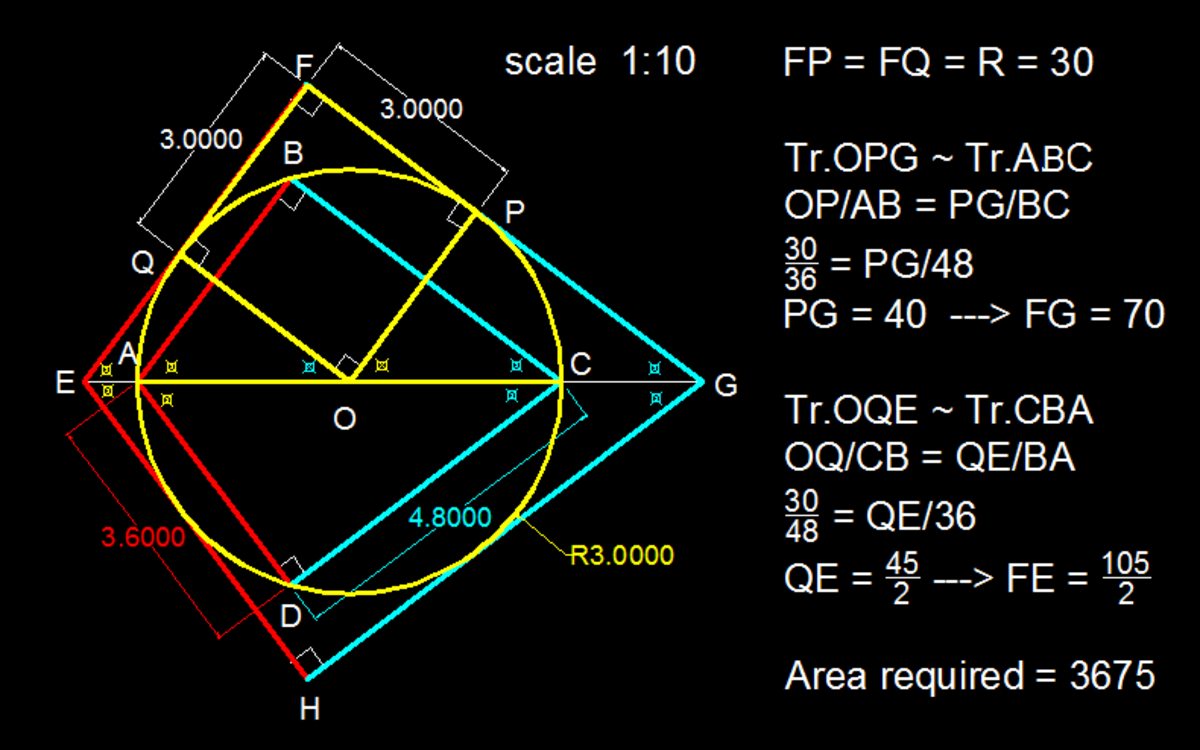101 Followers Question by Dr. Warm
Let the kite A B C D be inscribed in a circle, which is an incircle inside the kite E F G H , as shown above.
If both kites are similar with A B = 3 6 and B C = 4 8 , what is the area of the kite E F G H ?
The answer is 3675.
This section requires Javascript.
You are seeing this because something didn't load right. We suggest you, (a) try
refreshing the page, (b) enabling javascript if it is disabled on your browser and,
finally, (c)
loading the
non-javascript version of this page
. We're sorry about the hassle.
3 solutions
These are square kite. The radius of the circumcircle of small kite,
R
=
2
1
∗
3
6
2
+
4
8
2
=
3
0
.
But this is the inradius of the big kite.
The right triangles are 3-4-5. If the kite has sides a, b, it area is ab, and inradius
a
+
b
a
b
=
r
.
A square kite with side 3,4 will have inradius
r
=
3
+
4
3
∗
4
=
7
1
2
.
A
n
d
t
h
e
a
r
e
a
=
3
∗
4
=
1
2
So the ratio between the sides of big kite and this 3,4 similar kite is
k
=
7
1
2
3
0
=
2
3
5
.
A
r
e
a
o
f
b
i
g
k
i
t
e
=
1
2
∗
(
2
3
5
)
2
=
3
6
7
5
.
A typo:-Tr.OPG ~Tr.A B C.

Geometrically, the kite can be inscribed in a circle if and only if it's the right kite, or the kite that has right angles. In other words, its long diagonal will be the diameter of the circumcircle.
Let r be the radius of the circle in the question.
Then 4 r 2 = 3 6 2 + 4 8 2 .
r = 1 8 2 + 2 4 2 = 3 0 .
Now considering the kite E F G H , since all four sides are tangents of the circle, the radius r will be the height of the the triangles with each side as the base.
Therefore, the area of E F G H = 2 × ( 2 1 × r × ( E F + F G ) ) .
Since both kites are similar, the ratio of the sides are the same. That is, E F = k ( A B ) = 3 6 k and F G = k ( B C ) = 4 8 k for some constant k .
Thus, the area of E F G H = 3 0 × ( 3 6 k + 4 8 k ) = 2 5 2 0 k .
Alternatively, since the kite E F G H is made up of two right triangles, the area also equals
2 × ( 2 1 × E F × F G ) = k 2 ( 3 6 × 4 8 ) = 1 7 2 8 k 2 .
Solving for k , we will get: 2 5 2 0 k = 1 7 2 8 k 2 . k = 1 7 2 8 2 5 2 0 = 2 4 3 5 .
Therefore, the area of E F G H = 2 5 2 0 × 2 4 3 5 = 3 6 7 5 .